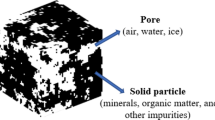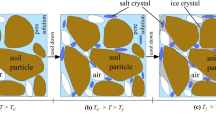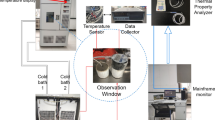Abstract
Purpose
This paper studies the effects of non-aqueous phase liquids (NAPLs) content and soil structural anisotropy on the thermal conductivity of NAPLs-contaminated soils, providing theoretical support for selecting heating methods and parameters in in situ thermal desorption remediation technology for NAPLs-contaminated soils.
Materials and methods
The feasibility of establishing the NAPLs-contaminated soil model using a random four-parameter generation method and calculating its thermal conductivity based on lattice Boltzmann method (LBM) is verified by testing the thermal conductivity of remolded soil samples with different porosities and diesel content. Then, the numerical simulation method is extended to study the thermal conductivity of NAPLs-contaminated soils with an anisotropy structure.
Results
The thermal conductivity of NAPLs-contaminated soils increases with the increase in the diesel content and decreases with porosity increase. The diesel content and effect of "liquid bridges" significantly impact the thermal conductivity of NAPLs-contaminated soils with large porosity and a high degree of anisotropy. According to the angle between the direction of soil pore connection and heat conduction, the Sr–ky : kx curves are divided into two types of trend lines with the included angle of 45° as the boundary.
Conclusions
Porosity, saturation, and anisotropy significantly affect the thermal conductivity of NAPLs-contaminated soils. The thermal conductivity of NAPLs-contaminated soils is largest when the heat conduction direction is consistent with the pore connection direction of NAPLs-contaminated soils. The thermal conductivity of anisotropic NAPLs-contaminated soils with high NAPLs content tends to be isotropic. The porosity, NAPLs content, and anisotropy of soil structure should be fully considered in the in situ thermal desorption remediation of NAPLs-contaminated soils.









Similar content being viewed by others
References
AbuHamdeh NH, Khdair AI, Reeder RC (2001) A comparison of two methods used to evaluate thermal conductivity for some soils. Int J Heat Mass Transfer 44:1073–1078. https://doi.org/10.1016/s0017-9310(00)00144-7
Cui H, Zhou J, Li Z, Gu C (2021) Editorial: Soil and Sediment Pollution, Processes and Remediation. Front Environ Sci 9. https://doi.org/10.3389/fenvs.2021.822355
Dao LQ, Delage P, Tang A-M, Cui Y-J, Pereira JM, Li XL et al (2014) Anisotropic thermal conductivity of natural Boom Clay. Appl Clay Sci 101:282–287. https://doi.org/10.1016/j.clay.2014.09.003
Deng P, Zhu J (2015) Anisotropy of Unsaturated Layered Soils: Impact of Layer Composition and Domain Size. Soil Sci Soc Am J 79:487–494. https://doi.org/10.2136/sssaj2014.08.0309
El Idi MM, Karkri M, Kraiem M (2021) Preparation and effective thermal conductivity of a Paraffin/ Metal Foam composite. J Energy Storage 33. https://doi.org/10.1016/j.est.2020.102077
Falciglia PP, Scandura P, Vagliasindi FGA (2018) Modelling and preliminary technical, energy and economic considerations for full-scale in situ remediation of low-dielectric hydrocarbon-polluted soils by microwave heating (MWH) technique. J Soils Sediments 18:2350–2360. https://doi.org/10.1007/s11368-017-1682-8
Fei SZ, Tan XH, Sun ZH, Du LF (2019) Analysis of autocorrelation distance of soil based on microstructure simulation. Rock Soil Mech 40:4751–4758. https://doi.org/10.16285/j.rsm.2018.2089
He Y, Dai L, Kim DY, Li H, Karato S (2021) Thermal Ionization of Hydrogen in Hydrous Olivine With Enhanced and Anisotropic Conductivity. J Geophys Res-Sol Ea 126. https://doi.org/10.1029/2021jb022939
Hlavacova Z, Bozikova M, Hlavac P, Regrut T, Ardonova V (2018) Selected physical properties of various diesel blends. Int Agrophys 32:93–100. https://doi.org/10.1515/intag-2016-0095
Hussain M, Tao WQ (2020) Thermal conductivity of composite building materials: A pore scale modeling approach. Int J Heat Mass Transfer 148. https://doi.org/10.1016/j.ijheatmasstransfer.2019.118691
Kingston JLT, Dahlen PR, Johnson PC (2012) Assessment of Groundwater Quality Improvements and Mass Discharge Reductions at Five In Situ Electrical Resistance Heating Remediation Sites. Ground Water Monit Rem 32:41–51. https://doi.org/10.1111/j.1745-6592.2011.01389.x
Krouzek J, Durdak V, Hendrych J, Masin P, Sobek J, Spacek P (2018) Pilot scale applications of microwave heating for soil remediation. Chem Eng Process 130:53–60. https://doi.org/10.1016/j.cep.2018.05.010
Li KQ, Li D-Q, Liu Y (2020) Meso-scale investigations on the effective thermal conductivity of multi-phase materials using the finite element method. Int J Heat Mass Transfer 151. https://doi.org/10.1016/j.ijheatmasstransfer.2020.119383
Li KQ, Miao Z, Li DQ, Liu Y (2022) Effect of mesoscale internal structure on effective thermal conductivity of anisotropic geomaterials. Acta Geotech. https://doi.org/10.1007/s11440-022-01458-z
Li SJ, Zhang DG, Liu YX (2007) Numerical simulation of the relationship between thermal conductivity of geotechnical material and Iits porosity. Rock Soil Mech 28:242–248
Liu Y, Yu M, Tian Y, Qin Q (2017) Published. Study of thermal conductivity measurement accuracy of wet porous media. In 10th International Symposium on Heating, Ventilation and Air Conditioning (ISHVAC), Jinan, China 205:1755–1761. https://doi.org/10.1016/j.proeng.2017.10.025
Lu J, Wan X, Yan Z, Qiu E, Pirhadi N, Liu J (2022) Modeling thermal conductivity of soils during a freezing process. Heat Mass Transfer 58:283–293. https://doi.org/10.1007/s00231-021-03110-0
Lu S, Ren T, Gong Y, Horton R (2007) An improved model for predicting soil thermal conductivity from water content at room temperature. Soil Sci Soc Am J 71:8–14. https://doi.org/10.2136/sssaj2006.0041
Maeda K, Tsunetsugu Y, Miyamoto K, Shibusawa T (2021) Thermal properties of wood measured by the hot-disk method: comparison with thermal properties measured by the steady-state method. J Wood Sci 67. https://doi.org/10.1186/s10086-021-01951-1
Midttomme K, Roaldset E (1999) Thermal Conductivity of Sedimentary Rocks: Uncertainties in Measurement and Modelling 158:45–60
Naidu AD, Singh DN (2004) A generalized procedure for determining thermal resistivity of soils. Int J Therm Sci 43:43–51. https://doi.org/10.1016/s1290-0729(03)00103-0
Pu Y, Ma P, Chen H, Li D, Arici M (2020) Characterization investigation on pore-resistance relationship of oil contaminants in soil porous structure. J Petrol Sci Eng 191. https://doi.org/10.1016/j.petrol.2020.107208
Qin X, Cai J, Zhou Y, Kang Z (2020) Lattice Boltzmann simulation and fractal analysis of effective thermal conductivity in porous media. Appl Therm Eng 180. https://doi.org/10.1016/j.applthermaleng.2020.115562
Rao M, Singh DN (1999) A generalized relationship to estimate thermal resistivity of soils. Can Geotech J 36:767–773. https://doi.org/10.1139/t99-037
Rizvi ZH, Shrestha D, Sattari AS, Wuttke F (2018) Numerical modelling of effective thermal conductivity for modified geomaterial using lattice element method. Heat Mass Transfer 54:483–499. https://doi.org/10.1007/s00231-017-2140-2
Różański A (2022) Relating thermal conductivity of soil skeleton with soil texture by the concept of “local thermal conductivity fluctuation”. J Rock Mech Geotech Eng 14:262–271. https://doi.org/10.1016/j.jrmge.2021.06.008
Sun J, Pan L, Tsang DCW, Zhan Y, Zhu L, Li X (2018) Organic contamination and remediation in the agricultural soils of China: A critical review. Sci Total Environ 615:724–740. https://doi.org/10.1016/j.scitotenv.2017.09.271
Tetteh J, Bai S, Kubelka J, Piri M (2022) Wettability reversal on oil-wet calcite surfaces: Experimental and computational investigations of the effect of the hydrophobic chain length of cationic surfactants. J Colloid Interface Sci 619:168–178. https://doi.org/10.1016/j.jcis.2022.03.114
Tokoro T, Ishikawa T, Shirai S, Nakamura T (2016) Estimation methods for thermal conductivity of sandy soil with electrical characteristics. Soils Found 56:927–936. https://doi.org/10.1016/j.sandf.2016.08.016
Wang G, Yang D, Kang Z, Zhao J (2018) Anisotropy in Thermal Recovery of Oil ShalePart 1: Thermal Conductivity, Wave Velocity and Crack Propagation. Energies 11. https://doi.org/10.3390/en11010077
Wang M, Liu H, Zak D, Lennartz B (2020) Effect of anisotropy on solute transport in degraded fen peat soils. Hydrol Processes 34:2128–2138. https://doi.org/10.1002/hyp.13717
Wang M, Pan N (2008) Modeling and prediction of the effective thermal conductivity of random open-cell porous foams. Int J Heat Mass Transfer 51:1325–1331. https://doi.org/10.1016/j.ijheatmasstransfer.2007.11.031
Wang M, Pan N, Wang J, Chen S (2007a) Mesoscopic simulations of phase distribution effects on the effective thermal conductivity of microgranular porous media. J Colloid Interface Sci 311:562–570
Wang M, Wang J, Pan N, Chen S (2007b) Mesoscopic predictions of the effective thermal conductivity for microscale random porous media. Phys Rev E 75. https://doi.org/10.1103/PhysRevE.75.036702
Wang M, Wang J, Pan N, Chen S, He J (2007c) Three-dimensional effect on the effective thermal conductivity of porous media. J Phys D Appl Phys 40:260–265. https://doi.org/10.1088/0022-3727/40/1/024
Wu C, Zhang T, Fu J, Liu X, Shen B (2020) Random pore structure and REV scale flow analysis of engine particulate filter based on LBM. Open Phys 18:881–896. https://doi.org/10.1515/phys-2020-0208
Yao R (2019) Study on influencing factors of thermal conductivity of changchun area silt clay. Dissertation for degree of M.D, Jilin University
Yuan X, Li N, Zhao X, Li Q (2010) Study of thermal conductivity model for unsaturated unfrozen and frozen soils. Rock Soil Mech 9:2689–2694
Yun TS, Santamarina JC (2008) Fundamental study of thermal conduction in dry soils. Granul Matter 10:197–207. https://doi.org/10.1007/s10035-007-0051-5
Zhang F, Cui YJ, Zeng L, Conil N (2019) Anisotropic features of natural Teguline clay. Eng Geol 261. https://doi.org/10.1016/j.enggeo.2019.105275
Zhang H, Shang C, Tang G (2022) Measurement and identification of temperature-dependent thermal conductivity for thermal insulation materials under large temperature difference. Int J Therm Sci 171. https://doi.org/10.1016/j.ijthermalsci.2021.107261
Zhang T, Cai G, Liu S, Puppala AJ (2017) Investigation on thermal characteristics and prediction models of soils. Int J Heat Mass Transfer 106:1074–1086. https://doi.org/10.1016/j.ijheatmasstransfer.2016.10.084
Zhao J, Fu D, Li Y, Jiang Y, Xu W, Chen X (2018) REV-scale simulation of gas transport in shale matrix with lattice Boltzmann method. J Nat Gas Sci Eng 57:224–237. https://doi.org/10.1016/j.jngse.2018.07.008
Zhao Y, Mahmood N, Coffman RA (2020) Soil Fabric and Anisotropy as Observed Using Bender Elements during Consolidation. Int J Geomech 20. https://doi.org/10.1061/(asce)gm.1943-5622.0001630
Zhou Y (2019) Macro-mesoscopic study of dual-porosity effects on soil thermal conduction. Dissertation for degree of PhD, Nanjing University
Zhu J (2020) Unsaturated cell model of effective thermal conductivity of soils. SN Appl Sci 2. https://doi.org/10.1007/s42452-020-03211-1
Funding
This study was financially supported by the National Natural Science Foundation of China (Grant No, 41402246) and the Engineering Research Center of Geothermal Resources Development Technology and Equipment, Ministry of Education, Jilin University.
Author information
Authors and Affiliations
Contributions
Lizhi Du and Yalu Han made contributions to conception and design, and/or acquisition of literature, and/or analysis, and writing the manuscript. Xinmin Hu and Yin An made equal contributions to acquisition of literature, and/or analysis. Yanlong Wang and Chenyang Liu participated in revising the manuscript critically for important intellectual content. Lizhi Du gave final approval of the version to be submitted and any revised version.
Corresponding author
Ethics declarations
Conflict of interest
The authors declare that they have no known competing financial interests or personal relationships that could have appeared to influence the work reported in this paper.
Additional information
Responsible editor: Daniel CW Tsang
Publisher's Note
Springer Nature remains neutral with regard to jurisdictional claims in published maps and institutional affiliations.
Supplementary Information
Below is the link to the electronic supplementary material.
Rights and permissions
Springer Nature or its licensor holds exclusive rights to this article under a publishing agreement with the author(s) or other rightsholder(s); author self-archiving of the accepted manuscript version of this article is solely governed by the terms of such publishing agreement and applicable law.
About this article
Cite this article
Han, Y., Wang, Y., Liu, C. et al. Study on thermal conductivity of non-aqueous phase liquids-contaminated soils. J Soils Sediments 23, 288–298 (2023). https://doi.org/10.1007/s11368-022-03310-z
Received:
Accepted:
Published:
Issue Date:
DOI: https://doi.org/10.1007/s11368-022-03310-z




